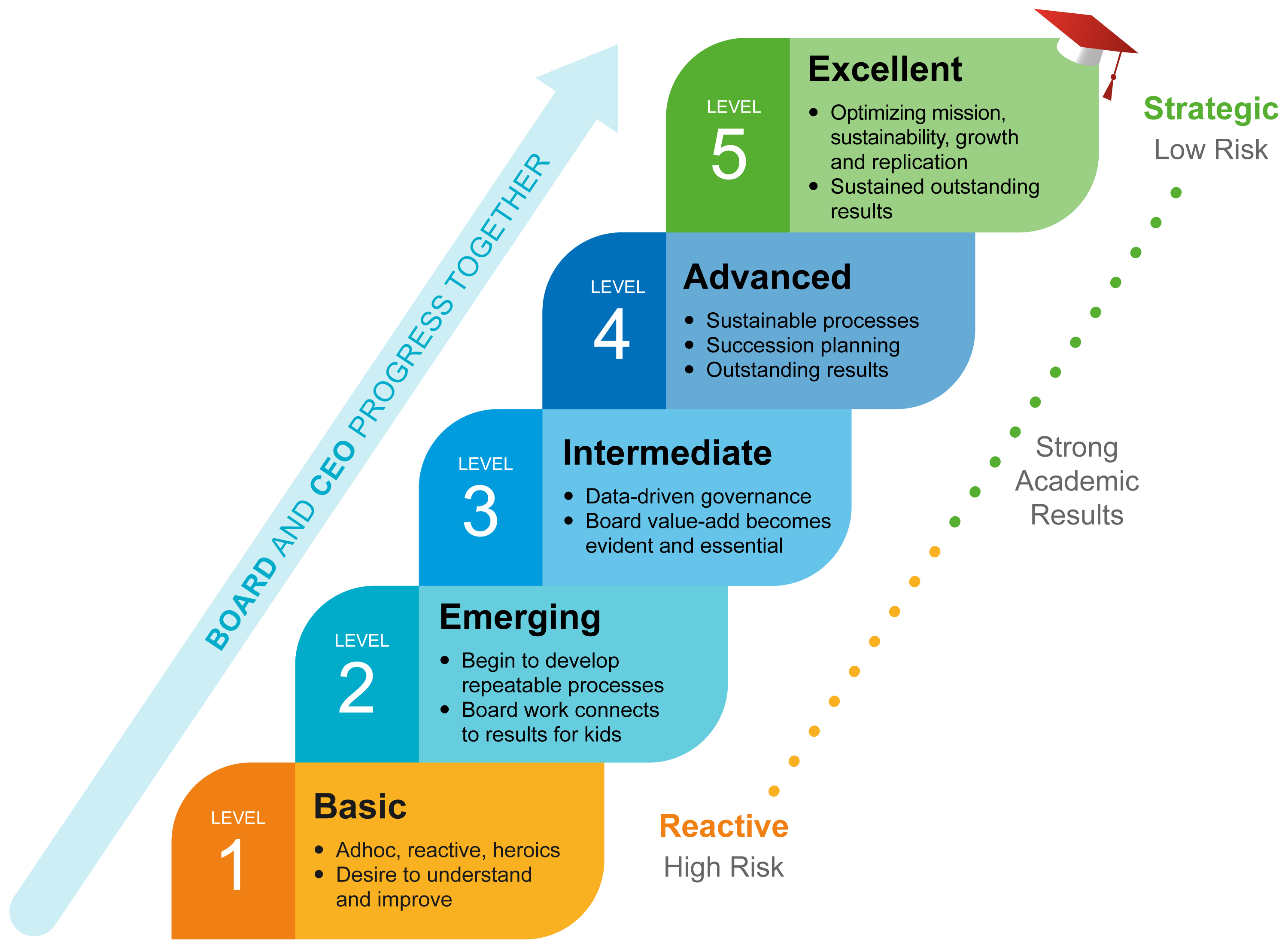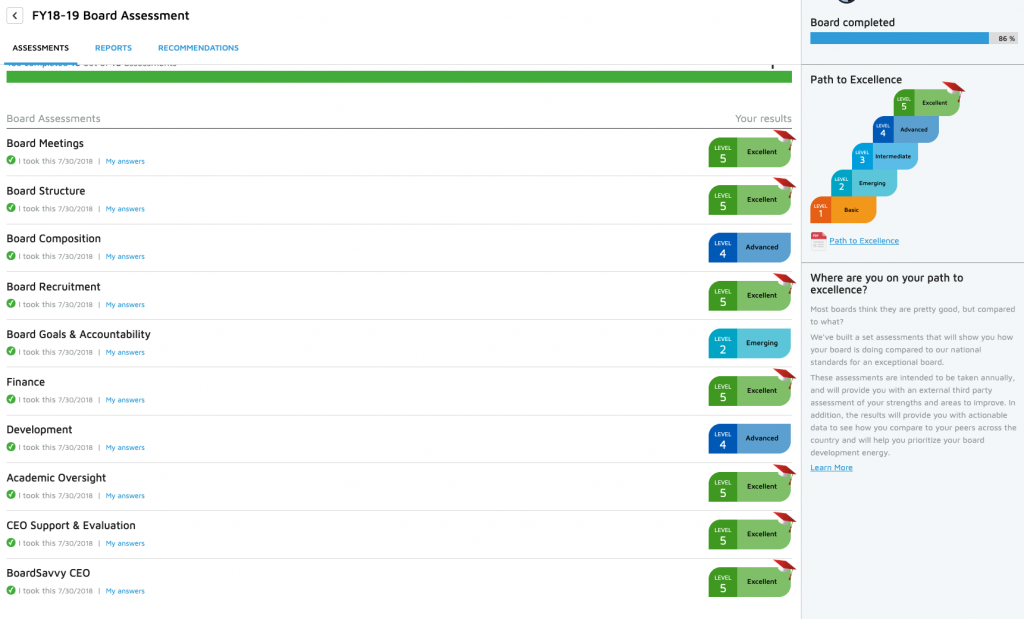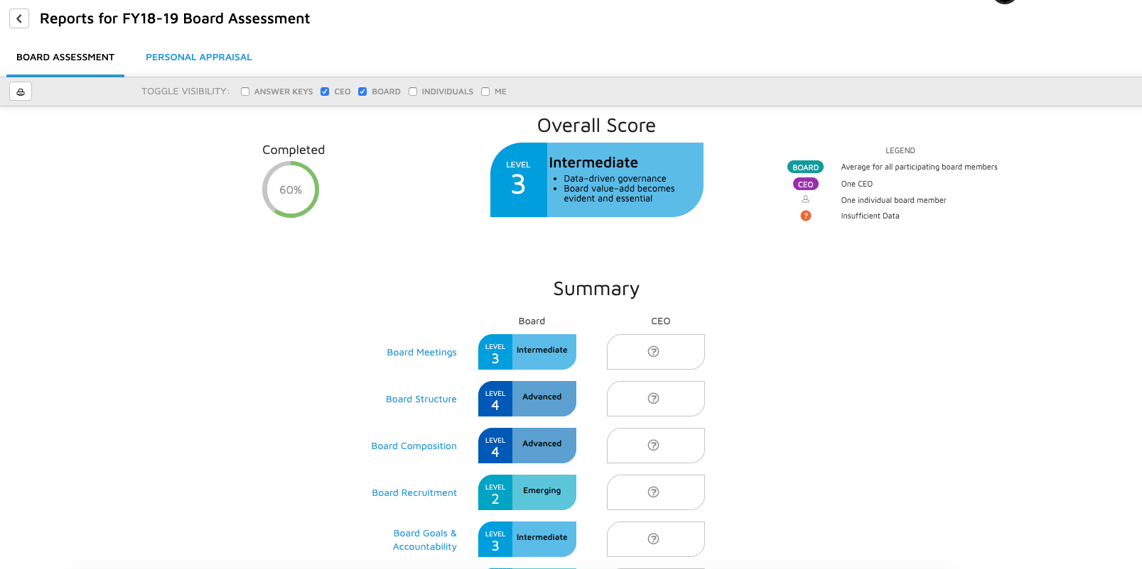How effective is your board?
This question always drives home for people quickly why an annual board assessment is so important. When we travel around the country to talk with charter school boards, we always ask this one. And we generally get answers like, “We’re doing pretty good. Our board is pretty effective.”
But, then we follow up with, “Well, how do you know? Pretty good compared with what?”
With that, things usually get a bit murky.
But to deliver the exceptional results promised in your charter, you’ve got to be able to answer these questions fully. And the only way to do that is with data. That’s what a board assessment delivers.
Board assessments matter because measuring your performance is a vital part of board governance.
Every charter school is a multi-million dollar public entity.
Unlike a traditional public school, with the infrastructure of the local government behind it, your trustees are responsible for representing the community and the public; for governing this organization.
And yet, when faced with these questions, too many charter boards realize that they’re running on assumptions. They’re making assumptions about how well they’re governing. And they don’t have much data — if any — to support their assumptions. They think they’re pretty good. But they don’t know.
There’s so much riding on what you’re doing. There’s no room for guesswork. In doing an annual assessment, you recognize that you are a multi-million dollar public entity with a lot at stake.
In short, completing an annual board self-assessment is absolutely essential to fulfilling your charter promises.
The surprising ways an annual board assessment boosts your board.
When done effectively, an annual assessment will provide the data you need to prove your board’s results — and identify where you can do better. But, it can do even more.
Your board assessment should lead towards higher engagement among your board members. It should help improve retention for your really effective trustees. And, data-driven assessments can actually help with attrition of some of those board members — those who might be counterproductive or actually bogging things down for the board.
What’s more, it should lead to a stronger partnership between the board and the CEO.
It’s very difficult for board members and CEOs to understand the full breadth of everything that an excellent board and excellent governing team can or should be doing. The process of evaluating the board and aligning on where to go next is the best tool and making sure that the CEO and the board are in lockstep as to where the organization needs to develop.
And that, in turn, results in a stronger organization overall.
An annual board assessment moves your board along the path to excellence
No organization is born or founded with a sustaining board that can deliver exceptional results.
Boards often think they’re pretty good because they’re not really clear about what they should be doing. You stay reactive because you’re not sure how to function any other way.
And your founding board is inherently going to be reactive. You’re going to rely on your school leader, or a couple of hard-working board members, at first.
But boards develop and evolve over through what we call the path to excellence — our governance capability maturity model. The Path to Excellence outlines the specific stages and steps that a charter governing board follows on its way to reaching excellence.

By the time you’ve got your feet under you and you’ve become a well-oiled machine, the board’s work should be much more strategic. The board should increasingly spend its time optimizing the mission, focusing on growth and replication, ensuring that there are sustainable processes in place so that the organization can sustain in perpetuity, regardless of who the individual personalities are in each seat.
Doing an annual board assessment gives you the guardrails you need to, methodically and strategically, become a less reactive board and a more strategic one. It helps you gain an understanding of where you are on this path to excellence, and how to move to the next stage.
And the BoardOnTrack assessment then gives you the tools and resources you need to evolve, year over year, up this path to the point where you become a Level Five strategic board.
How to evolve, year over year, through the annual cycle of board development.
The way that BoardOnTrack lights a fire under boards, to help them deliver exceptional results, is through our process of assessing, aligning, accelerating; and re-calibrating as necessary.
Assess
On an annual basis, the board should use a board assessment to take stock of its current strengths. And find opportunities for development.
An annual board assessment process is key here. And, below, I’ll describe how our proven process works.
Suffice it to say, you’re going to lead an assessment of your full board and individual trustees.
For this process to be open, honest, and productive, everyone should acknowledge at the outset that opportunities to grow are not problems. Room to grow is inherent in the evolution of any organization. Of course, your governance capabilities and structure should evolve over time. And that means you’re not doing everything perfectly.
In this stage, the Governance Committee leads your board’s assessment process, reviews the findings, and guides the board through conversations that make the findings actionable.
Align
Perhaps you’re in your second year of operations and you’re ready to evolve from a seven-person board to an 11-person board, in order to have more robust committees.
Or, you’ve set a goal of providing tighter financial oversight. You might want to do an audit this year, and have monthly meetings to review budget-to-actuals.
Whatever your priorities are, you’re going to align on what things you need to do differently this year as a board in order to have a stronger governance presence. And you’re going to frame these things as SMART goals.
Once you’ve aligned on what these board-level goals are going to be, your committees turn them into their own SMART goals. You can pull back to a previous BoardSavvy™ training if you’re interested in learning more about how the committees turn their priorities into smart goals.
Accelerate
Once the full board’s aligned on what it is that you want to do to get better going forward, the next part is that you accelerate this work.
This is how you stay laser-focused on what those goals are throughout the next year.
When you build your meetings and your agendas and your annual calendar for the year, it should be focused around these strategic goals. And make sure that you’re building in sufficient time to have tough conversations, and to actually take a vote.
Recalibrate
Throughout the year, it’s important to know that these goals should not be a set it and forget it kind of exercise. These goals should be front and center in your mind — at every board meeting, every committee meeting, you’re focused on how you’re contributing to achieving your board’s goals.
If a goal or priority has been solved or is no longer a top priority, maybe things have changed and there might be a new direction that the board wants to head in.
I strongly encourage that, rather than throwing out those goals and not following them throughout the year, you take the time to recalibrate as a board. Adjust those priorities. Have a conversation. Are these five goals still our top five goals? If not, why? What should they be? This is a perfect exercise for a winter or mid-year retreat or strategic planning exercise.
Recalibrate as needed and stay focused on the right goals for the remainder of the year.
The 8 proven steps of our annual board assessment process
These are the specific, actionable steps, that you and your board will follow.
1. Make sure you’ve got a Governance Committee in place to lead your board assessment.
Think of the annual board self-assessment as you would your annual physical. When it’s time for your annual physical, you’re going to see the doctor. She’ll run some tests, provide diagnoses, and advise you to take steps throughout the year to get healthier. You’ll follow those steps, then head back to the doctor for another physical and another round of assessments to see how you’ve done and where you can be healthier.
First, you’d need to line up a doctor.
So, line up that Governance Committee first. Their purpose is to maintain the overall health of the board. They’ll run your assessments. Then, they’ll lead you through the steps you need to take to become a healthier governance team throughout the year.
The Governance Committee can help educate the board as to why you’re engaging in this process.
The Governance Committee as a whole, the committee chair, the Board Chair, or whomever your strategic champion is, should explain to the board why they’re doing this. They should explain the annual cycle of board development, and how an assessment fits in. They should explain that this is just the first step in what the board members should expect they’re going forward. You might have this conversation when you vote on your timeline {see the next step, below}.
Make sure you have a true Governance Committee in place.
Sometimes, we see what I call paper committees. That’s when there’s a Governance Committee in the bylaws; maybe there’s a chairperson identified. But, they don’t actually meet. They’re not actually contributing to their fullest.
Your board assessment is the perfect project to start with launching the Governance Committee.
If you’re a new organization or a relatively young organization, you’re building the airplane as you fly it.
You might not have all of your committees in place yet. But, the Governance Committee is typically the first or one of the first committees to implement because they have such a critical role in supporting the work of the governing board.
That’s because the things this committee owns are going to be included in that annual assessment — your approach to recruiting and nominating trustees, succession planning, board development, and more.
If you don’t have a Governance Committee in place, grab our sample job description. You can download that, customize it and make it your own. This can be the foundation for launching your Governance Committee and your assessments.
2. Develop a timeline for your board assessment process.
As a team, develop a timeline for when your board’s assessment work will be finished.
Vote on it, or at least ratify your timeline, at a full board meeting. That way, it’s an official act of the board. It gives it the gravitas that we think that this process deserves.
Build your timeline to line up with your school year.
Typically, boards will begin their assessment towards the end of the school year. That way, you have the entire school year to reflect back on. And you can finish your assessment right before your annual retreat, which tends to be over the summer.
This allows you to use the results to influence the conversation at your retreat. Strategic conversations like goal setting, or tactical ones like selecting officers, should be data-driven using the results of your annual assessments.
Don’t give your board members too much time to complete these assessments.
You don’t want people to overthink it. You want people to go through the questions with what their gut tells them and then use the data from there. So provide a reasonable but short enough turnaround time to create an appropriate sense of urgency. If you have one person who’s late or needs some flexibility, work with that person.
3. Pick a proven tool to run your board assessment on.
What evaluation system or tool are you going to use?
Luckily, BoardOnTrack members have a tried-and-true, road-tested with hundreds of charter schools, built-in assessment tool. {There are also homegrown tools available, too.}
Take a look at the assessment in the platform {or join our next live demo to see it in action}.

Consider whether the tool you’re using will assess the performance of the entire board as one collective entity, as well as for individual trustees. You really want to get an appraisal of each trustee’s performance as an individual board member, in addition to the board overall. BoardOnTrack is built to do exactly that.
The governance practices required to be a really high-functioning charter school board are pretty universal. So, don’t reinvent the wheel here. There are plenty of opportunities for you to innovate in your charter school. That’s why you’ve joined one — or launched one.
4. The full board and the CEO will complete the board assessment.
It goes without saying that each board member will complete your board assessment. But, the CEO should also participate in this.
Why is it so important? We know that the CEO plays an absolutely essential role in every governance team. While not being a full voting board member, the CEO brings a unique window into how the board contributes to the organization. Their expertise is going to be invaluable.
So, make sure your CEO does the assessment. As well as every trustee, of course.
While we encourage the full board to speak with one voice, the CEO is an important voice to hear. So BoardOnTrack’s board assessment tool is built to anonymize and aggregate the responses from individual board members. And the results of your CEO will be transparent. You’ll know what they answered.
5. Talk about your board assessment results with the full board.
Once everyone’s completed the assessments, it’s important to actually take that data and have a conversation about it.
You’re not looking to check the box; to say, “Great, I went in and completed the assessments.” You really want to use those assessments to influence your board’s work going forward.
Your Governance Committee will review the data and present it to the full board. Then, the full board will discuss the findings. Based on this data and your understanding of your direction as an organization, you’ll identify the three-to-five board development priorities you’ll address this year.
A great place to start with analyzing your data is to look find the places where there’s alignment — or misalignment — between the board as a whole, and the CEO.
For example, if the full board believes that the recruiting efforts for new board members is great, but the CEO thinks it’s wholly insufficient, that’s an interesting kicking off point for a conversation. Why is it that the board thinks that they’re doing pretty good job here, but the executive staff see room for growth?
Ideally, at your annual board retreat, you hold a strategy session — a significant chunk of time to look closely at your results. Give the data to the board in advance, so that they can review the data independently and develop some stronger, data-driven opinions on where they think the board needs to go.
6. Discuss each board member’s individual assessment results with them directly. And take action where needed.
I want to reemphasize the importance of selecting a tool that includes an assessment of individual board member performance. We encourage the chair of the Governance Committee and the Board Chair to set up individual meetings with each trustee, to review their results.
Individual board member appraisals are a great way for individual board members to get a sense of how they’re performing compared to the rest of the group.
You want to see how each trustee is performing in comparison with the full board, as well as in comparison against what the typical charter school board member looks like.
Each board member should ask themselves: In which areas do we as a board need to evolve? How did the full board answer on each section? How did the CEO answer? Where was my answer in that spread?
It gives a jumping-off point for board members to identify areas where they don’t feel they have the kind of understanding or governance capabilities that they want or the board needs of them.
These individual board member appraisals can also help address trustee performance challenges.
Generally, board members are doing the best they can. But the unfortunate reality is that, sometimes, you have board members who simply are not the right fit or now is just not the right time for them to be on your board. And, like with the full board report, the individual assessment could open your eyes to the expectations and responsibilities that the ideal charter school trustee board member should live up to.
For instance, attendance is critical. The real work happens in meetings. If you have a board member who’s chronically absent, not only are they doing themselves a disservice, they’re possibly running afoul of their fiduciary duties because, by not showing up consistently, they’re not actually fulfilling the role of a board member. They’re also doing a massive disservice, not just to the board, but the organization as a whole.
Sometimes, the data can make a conversation with a trustee like this easier — or unnecessary. It’s not…we don’t think you’re attending enough meetings. It’s…here’s what the data shows. And, when a person sees the reality in black and white, they might self-select out of the board.
This is not something that happens often. But, when you do have a board member who’s counterproductive — because they don’t attend meetings or they’re disruptive at meetings or aren’t aligned with the mission and vision — you’ll want to have the benefit of data as the basis of a conversation. You’ll have to ask yourself one of two questions. Should you renew their term? Should you ask them to step down?
7. Use data to inform nomination for board officer roles for next year.
The individual performance data can help you suss out who your future Board Chair might be. And to help that person begin ramping up into that role, to even out the learning curve.
8. Incorporate your board assessment results into your annual board goal-setting process.
In the annual board development cycle of assess, align, accelerate, this is the alignment phase.
Each committee will have goals that come out of your board assessment data. For the Governance Committee, there will likely be some goals related to recruitment, orientation, or an annual retreat.
Any weaknesses will need to be addressed, and you’ll want to set goals to do that. For instance, perhaps you identify that cash reserves are insufficient. The Finance Committee may use your data as the basis for setting a goal for the next year of increasing those cash reserves.
Think of prioritization when you’re going through the report. Think back to that in that path to excellence that I showed you at the beginning of the presentation, which went from step one, two, three, four, all the way to five. It’s important to remember that it’s not possible for a board to accomplish everything that a board ought to be doing one year to the next.
Just like if you’re trying to get stronger. You might go to a personal trainer. You’re still not going to have all the muscles that you wanted or to lose all the weight overnight. It takes time.
When you’re reviewing your results, note that, if you’re a Level One board, you probably shouldn’t start by setting goals that really are in line with how a Level Five board might perform. You want to decide the highest priority right now for your board.
The data is a tool to influence your conversations, to ensure you’re moving forward.
How the BoardOnTrack board assessment tools work.
BoardOnTrack’s board management platform includes the most robust board assessment tool available. And the only one designed specifically for charter governance boards.
We cover 11 different key subjects related to board governance. For example: your board meetings, some operational elements and those that relate to the Governance Committee because, again, the Governance Committee is here for the overall health and well-being of the board.
We measure how effective your board meetings are, how well your board is composed and structured, and even your board recruitment efforts.

Then, you get to dive into the more substantive areas — your financial oversight, academic oversight, and fundraising efforts.

And last but not least, you’ll find the personal individual appraisal.
Gaining all of this insight can happen with just about 30 to 40 minutes of each of your trustees’ time.
It’s not something to agonize over. Because again, the benefit of going through here is really we want to know your gut reaction. We don’t want you overthinking the answers.
Finally, your data is accumulated into a clean and simple report.
To understand the board’s overall score, you can drill through into multiple different levels. For each category, you can see the specific ratings each board member provided — to see where there’s alignment among trustees, and where there isn’t; or, where one or two trustees’ ratings are real outliers.
You want to look most closely at areas where the board thinks that they assess themselves at a basic or a lower level organization.
The other area which can almost be more valuable or influential to have as a conversation around is where there’s alignment and or misalignment between the board and the CEO in a particular area.
Data-driven governance is about using data to drive exceptional results for your board and your charter school.
Adopting data-driven governance means that you build a well of data, examine it to understand exactly what your board and your school leader think on each of these key areas, use that to have fruitful conversations, and make the right decisions.
The most important part isn’t getting each person to complete the assessment. The most important part is discussing it as a team and making sure that those results turn into real action.
The data in your assessment should open your eyes to things that you, as a board, aren’t doing or could do better. And, it should help each person on your team to understand where they need to educate themselves — or their colleagues — better as to the work that they’re doing.
This is about more than just checking a box, being able to say it’s done. The best, the highest-achieving boards that we work with, know that the assessment is just one step in a full, year-long board development cycle. And they use it to influence their goals. They’ve managed their goals all year long and then they take the assessment every year to understand where they may have improved and where they need to focus on in the future just to remind their, here’s what that process looks like.




